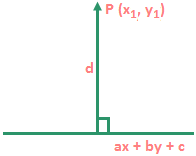The length of the perpendicular from a point (x₁, y₁) to a line ax + by + c = 0 is \(\left| \frac{a{{x}_{1}}+b{{y}_{1}}+c}{\sqrt{{{a}^{2}}+{{b}^{2}}}} \right|\).

The length of the perpendicular from the origin to the line ax + by + c = 0 is \(\frac{\left| c \right|}{\sqrt{{{a}^{2}}+{{b}^{2}}}}\).
Example: If P is the length of the perpendicular from the origin to the line \(\frac{x}{a}+\frac{y}{b}=1\) then prove that \(\frac{1}{{{p}^{2}}}=\frac{1}{{{a}^{2}}}+\frac{1}{{{b}^{2}}}\).
Solution: The given line is bx + ay – ab = 0 → (1)
It is given that P = Length of the perpendicular from the origin to (1)
= \(\frac{\left| b\left( 0 \right)+a\left( 0 \right)-ab \right|}{\sqrt{{{b}^{2}}+{{a}^{2}}}}\),
= \(\frac{ab}{\sqrt{{{a}^{2}}+{{b}^{2}}}}\),
⇒ \({{p}^{2}}=\frac{{{a}^{2}}{{b}^{2}}}{{{a}^{2}}+{{b}^{2}}}\),
⇒ \(\frac{1}{{{p}^{2}}}=\frac{{{a}^{2}}+{{b}^{2}}}{{{a}^{2}}{{b}^{2}}}\),
⇒ \(\frac{1}{{{p}^{2}}}=\frac{1}{{{a}^{2}}}+\frac{1}{{{b}^{2}}}\)
The distance between two parallel lines ax + by + c₁ = 0 and ax + by + c₂ = 0 is \(\frac{\left| {{c}_{2}}-{{c}_{1}} \right|}{\sqrt{{{a}^{2}}+{{b}^{2}}}}\).
The area of the parallelogram ABCD whose sides AB, BC, CD and DA are a₁x + b₁y + c₁ = 0, a₂x + b₂y + c₂ = 0, a₁x + b₁y + d₁ = 0 and a₂x + b₂y + d₂ = 0 is \(\left| \frac{\left( {{c}_{1}}-{{d}_{1}} \right)\left( {{c}_{2}}-{{d}_{2}} \right)}{\left| \begin{matrix}{{a}_{1}} & {{b}_{1}} \\{{a}_{2}} & {{b}_{2}} \\\end{matrix} \right|} \right|\).
Example: Prove that the four straight lines \(\frac{x}{a}+\frac{y}{b}=1\), \(\frac{x}{b}+\frac{y}{a}=1\), \(\frac{x}{a}+\frac{y}{b}=2\) and \(\frac{x}{b}+\frac{y}{a}=2\) form a rhombus. Find its area.
Solution: The equations of the four sides are
\(\frac{x}{a}+\frac{y}{b}=1\) … (1)
\(\frac{x}{b}+\frac{y}{a}=1\) … (2)
\(\frac{x}{a}+\frac{y}{b}=2\) … (3)
\(\frac{x}{b}+\frac{y}{a}=2\) … (4)
Clearly, (1), (3) and (2), (4) form two sets of parallel lines.
So, the four lines form a parallelogram.
Let p₁ be the distance between parallel lines (1) and (3) and p₂ be the distance between (2) and (4). Then,
\({{P}_{1}}=\left| \frac{2-1}{\sqrt{\frac{1}{{{a}^{2}}}+\frac{1}{{{b}^{2}}}}} \right|=\frac{ab}{\sqrt{{{a}^{2}}+{{b}^{2}}}}\),
\({{P}_{2}}=\left| \frac{2-1}{\sqrt{\frac{1}{{{a}^{2}}}+\frac{1}{{{b}^{2}}}}} \right|=\frac{ab}{\sqrt{{{a}^{2}}+{{b}^{2}}}}\).
Clearly, P₁ = P₂. So, the given lines form a rhombus.
Area of rhombus = \(\left| \frac{\left( 2-1 \right)\left( 2-1 \right)}{\left| \begin{matrix}\frac{1}{a} & \frac{1}{b} \\\frac{1}{b} & \frac{1}{a} \\\end{matrix} \right|} \right|\),
= \(\left| \frac{1}{\left( \frac{1}{{{a}^{2}}}-\frac{1}{{{b}^{2}}} \right)} \right|=\frac{{{a}^{2}}{{b}^{2}}}{\left| {{b}^{2}}-{{a}^{2}} \right|}\).
